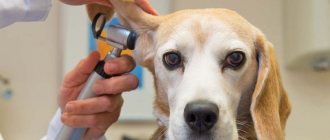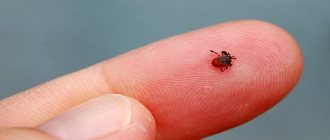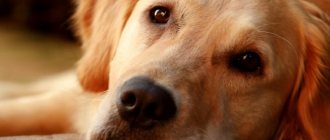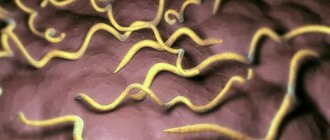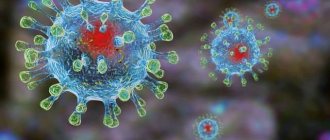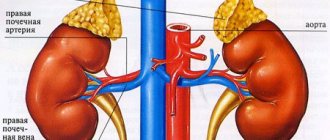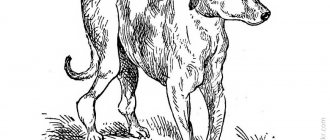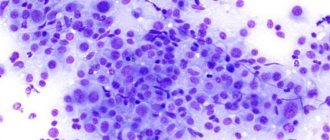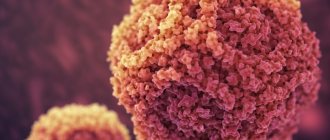Content
1. What is Giardia 2. The large scale of the problem 3. The main pathogenetic disorders 4. The course of the disease and symptoms of Giardiasis in dogs 5. How to treat this disease 6. Video about Giardiasis:
In European countries, it is customary to test for Giardia in four-legged fellow animals every year. Unfortunately, this practice is not widespread in Russia, and owners often neglect the health of their pet. The main danger of this disease is that it is not fatal, but the infection gradually eats away at the immune system. Then any disease, even the simplest one, can greatly damage the dog’s health and cause unpredictable reactions from any illness. In advanced forms, more vivid manifestations are possible. This usually affects chained dogs chained in yards. But pets also have a chance to ingest parasites on the street during play or through contact with a sick relative.
Mechanism and routes of infection
Giardia exists in two forms. In the external environment, under unfavorable conditions, they are in “sleeping mode”, in the form of cysts, surrounded by a durable protective shell. When a cyst enters the body of a warm-blooded animal, the cyst shell dissolves and two trophozoids, the active form of Giardia, emerge from it. Having attached themselves to the intestinal mucosa, they begin to feed and reproduce. During their life, trophozoids damage the intestinal wall and release metabolic products that are toxic to the animal’s body.
Giardia can remain viable in the external environment for a long time: in stagnant water for up to several months, in feces for about 3 weeks. The method of infection with giardiasis is nutritional (fecal-oral). A dog can swallow pathogen cysts:
- consuming contaminated food or water,
- when sniffing grass or soil,
- through direct contact with an infected relative or visiting a litter tray that was used by a sick animal.
What is Giardia
These are the simplest microorganisms, quite large in size. They are often compared to amoebas and leishmania. They cause a condition called giardiasis, which occurs in acute or chronic form. They most severely affect the intestines, where they linger until effective treatment begins. If you do not act in a timely manner, they form stable colonies on the walls and inside the tissues, which can cause general intoxication. Therefore, owners often blame everything on allergies, dermatitis or congenital neurological problems. Most often, inexperienced dog breeders confuse this disease with the following groups of diseases:
| Gastrointestinal disorders | Starting from loose stools, ending with suspicions of a swallowed foreign object. |
| Dysbacteriosis | Its main symptom is when excrement of radically different consistency (liquid and solid) is constantly present. |
| Poor absorption | The pet seems to be on a high-calorie diet, but weight loss still occurs or it stops there. This is due to damage to intestinal tissue. |
| Avitaminosis | Vitamin deficiency constantly appears, even though the dog receives vitamins at the norm or in excess. |
| Allergy | Spontaneous allergies to food or its skin manifestations appear. They are easier to recognize in smooth-haired breeds. This is especially noticeable on the back or in the armpits. |
| Keratin | The amount of keratin in the body is constantly changing. With an excess, seborrhea occurs, and with a deficiency, cracking occurs. |
All this can manifest itself in various combinations, subside, and then flare up again with renewed vigor. At the same time, the pet’s general health and immunity begins to melt literally before our eyes.
Large scale of the problem
According to statistics, up to 80% of dogs in kennels already carry Giardia. Therefore, before taking an animal into your home, you need to go to a veterinary clinic and wash your hands thoroughly. After all, all warm-blooded inhabitants of the planet are susceptible to the disease to one degree or another. About 10% of pets are also infected with parasites. And if they have Giardia, then their owners are also carriers by default. The disease is also considered dangerous for the following reasons:
- Young children who put everything in their mouths are most often infected. Their intestines cannot yet normally resist the simplest microorganisms, which leads to severe disorders of the digestive system.
- Diagnosis is extremely difficult. It is necessary to be tested specifically for Giardia, and not general parasitic samples of feces and blood. Detection requires highly specialized reagents, which are not available in every laboratory.
- If the pathology is identified and the diagnosis is made, then this disease can recur for a very long time, at different intervals, and doctors usually do not guarantee a successful complete cure.
The amazing resistance of Giardia comes from their ability to transform into extremely tenacious cysts that die only during prolonged boiling, in solutions of alkalis and acids, but are completely insensitive to freezing even in liquefied gases.
Diagnostics
Diagnosis is made based on the clinical picture of the disease. The veterinarian makes an assumption regarding the presence of parasites in the body and sends your dog for the following tests:
- stool analysis;
- scraping from the anus;
- blood test for the presence of lamblia.
Only a doctor can make the correct diagnosis and prescribe treatment
They look for cysts and traces of parasites in the stool. The analysis is taken repeatedly with an interval of several days. This is necessary to obtain reliable data; cysts cannot always be detected the first time. A blood test is the most reliable way to determine infection in the body, but it is labor-intensive and requires additional time. The presence of antibodies against Giardia is detected in the blood using special chemicals. Their presence in large quantities indicates the presence of a disease.
At the same time, an intestinal endoscopy is performed and a sample of the duodenal wall is taken. This is necessary to determine the depth of tissue damage by parasites. You can read below about what endoscopy is for dogs and how it is performed on animals.
Endoscopy for dogs
Main pathogenetic disorders
Dogs' intestines contain many villi, just like all mammals. The simplest microorganisms cling to these irregularities, essentially consuming the tip. And this is the most important part responsible for the absorption of nutrients. Also, against the background of these damages, immunity drops significantly and metabolism decreases. The intestines become immune to mechanical stress, the pet does not feel pain, because the nerve endings completely atrophy. Giardia waste products begin to acutely poison the body, and the protozoa themselves actively absorb nutrients.
Defeat is fraught with the following consequences:
- The intestinal epithelium cannot be regenerated even partially. Any injury, for example from a bone fragment, can lead to fatal consequences. Conventionally, cells can be divided into mature and young specimens. The second type absorbs nutrients more actively, but due to constant eating by Giardia, development into the final stage usually does not occur. Against this background, acute lactase deficiency occurs. In puppies, this inhibits development, and in adults, gradual depletion occurs.
- The intestinal walls become hypersensitive, allowing large molecules to enter the bloodstream. If we are talking about antigens, then you can automatically get an allergy with unpredictable triggering factors. A dog can get severe swelling due to running through blooming dandelions or carrots introduced into the diet.
- Parietal digestion stops working in the right way. In the feces you can observe the remains of undigested food, which provokes numerous putrefactive processes, causing diarrhea in combination with constipation. The same disorder is a catalyst for vitamin deficiency, blocking mineral supplements, in particular calcium. The amount of incoming riboflavin, the entire group of thiamines and vitamin C is especially strongly reduced. The fat-soluble group is absorbed very poorly.
- The liver does not perform its main filtration function. Poisoning can happen even when consuming a completely harmless food product. This also leads to damage to the pancreas and reduces the conductivity of the biliary tract due to the formation of various crystalline structures. Even complete obstruction is possible.
The course of the disease and symptoms of giardiasis in dogs
The incubation period can vary from 1 to 4 weeks. It all depends on the primary state of the animal’s immunity. The presence of Giardia in the intestines of an animal does not provide persistent signs for diagnosis, so the infection is often attributed to ordinary problems with the gastrointestinal tract. The nature of the disease can be intermittent, acute or chronic. It is extremely rare that animals are carriers. Usually these are primitive breeds that have excellent health.
Decreased appetite, nausea and flatulence are three sure signs. If they appear after relief of symptoms with the help of enterosorbents, then this is a reason to contact a veterinarian. Absorbing substances absorb accumulated poisons, and then Giardia again produces them at enormous speed. In puppies, palpation of the abdomen gives very good results. They begin to whine when trying to touch even a little. The cubs are far behind the norm in development; they also eat practically nothing and play very sluggishly.
Older dogs develop an unsightly appearance. The skin peels off, acquires a uniform brown tint everywhere, and an unpleasant rash appears, often turning into ulcers. The main mistake the owner makes is trying to treat it with allergic reaction medications on their own. Cracks on the lips may appear, and the breath may smell strongly of hydrogen sulfide. The animal exhibits belching, which is not typical for dogs.
Treatment
If your dog has been having diarrhea for some time, especially if it is accompanied by vomiting, this is a good reason to see a doctor.
Giardiasis in itself is not very dangerous. But prolonged diarrhea and vomiting seriously weaken the body, reduce immunity and “open” the door to many other infections.
Therefore, it is very important to consult a veterinarian in time.
It makes no sense to treat an animal at home, since vomiting and diarrhea can be caused by many other diseases, and self-medication can only make it worse.
The first thing you should do is put your dog on a starvation diet and go to the veterinarian for a full diagnosis.
How to treat this disease
| First day | The pet should be put on a diet, or better yet, put on a temporary hunger strike. Since appetite is at an extremely low level, this is very easy. To increase the effectiveness of drugs that suppress Giardia, it is necessary to cleanse the intestines and stomach. For this, astringents are used, enterosorbents such as Enterosgel, low-fat meat broth is useful for support, enemas and other laxatives can be used. |
| Second day | Should start with liquid porridges made from semolina, oatmeal or rice. They envelop the intestinal walls and also promote the adsorption of accumulated toxins. You can add a little ground beef to the porridge for taste. |
| The third day | Try to introduce a little fermented milk products into your diet. Lactic acid actively suppresses all groups of Giardia, and also reduces their resistance to drugs. |
Most often prescribed in the fight against these microorganisms
- Albendazole
- Fenbendazole
- Metronidazole
- Febtal
The latter option is quite good for suppressing Giardia. Course duration is 3 days.
Complex preparations containing anthelmintic components, such as praziquantel or pyrantel, are also often used in the treatment of dogs. The calculation is for every 10 kg of animal weight, and for small dogs the tablets will have to be divided. It is also advisable not to buy medications made for people. The course lasts 3 days, and after a week it must be repeated to destroy Giardia hatching from the cysts.
In chronic cases, up to 10 repetitions are possible under the supervision of a physician. In the most severe conditions, infusion therapy is performed, glucose and vitamins are administered intravenously to prevent them from being eaten by Giardia. It is also possible to use calcium supplements in old age. If persistent diarrhea causes dehydration, distilled water may be added. General supportive therapy is performed in parallel with drug treatment. This complex approach is most often used for dogs in an extremely malnourished state.
In addition to medications, a diet of special dry food may be prescribed. During the treatment period, Giardia must be completely deprived of basic nutritional resources. The process of taking medication is cyclical in order to kill the parasites that gradually emerge from the cysts.
When caring for a pet, it is necessary to completely change the sleeping place, and all family members should always wash their hands, preferably every hour. Where the animal could lie, sit or stand, you need to go through everything with a steam iron. You can use the services of a cleaning company. This is the so-called sterile cleaning. During the treatment period, it is better to remove the animal from the house, live in the country or somewhere outside the city, to eliminate the risk of re-infection. People should also be tested for giardiasis.
